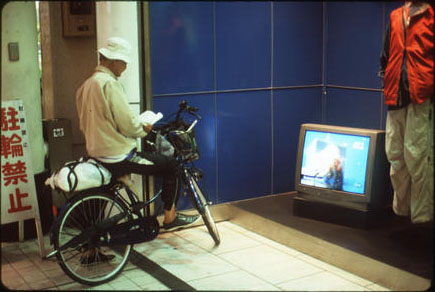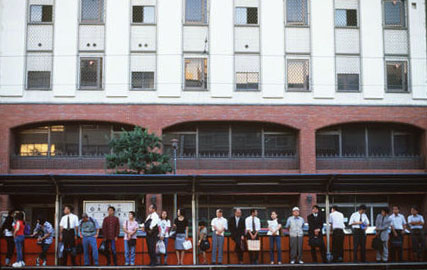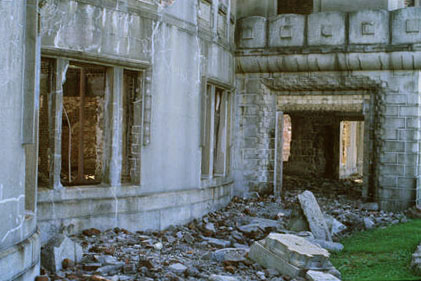
Ken, Kumamoto, Japan, September 11th, 2001.
On September 11th, 2001 I was in Kumamoto, a small city in the island of Kyushu, southern Japan. At around 7:00 p.m. I entered a small restaurant. I speak a little bit of Japanese, but I cannot read it- yet, so I pointed to a sign on the wall and with pride said "sore wa o kudasai" (please give me that). Of course, I had no idea what I was ordering, but I knew the price was reasonable and had guessed the type of food from the appearance of the restaurant.
My next day started very late, for I reached my minshuku (Japanese style hotel) around 7 a.m. When I got back into the city (the minshuku was in a somewhat secluded area) it was 4:00 p.m. on the 12th. It was not possible to find an English language newspaper, and the Japanese newspapers, for the most part, did not show images of people, but images of the burning buildings. It was not until the 13th, when I called New York, that I realized the magnitude of the tragedy. The movie-like images of the two burning buildings shown in televisions everywhere over and over again turned into a nightmare. The pain shifted from the loss of a place and a symbol to thoughts about the people who had lost their lives, and friends and families.
That feeling intensified when I visited Hiroshima and Nagasaki, two cities devastated by atomic bombs in 1945. Although those events in WW II were significantly different (in Hiroshima alone, approximately 200,000 civilians were killed instantly by the explosion and later from radiation), it was not difficult to make a parallel. The Hiroshima bomb exploded on a Monday morning on August 6th, 1945 at 8:15 a.m., in the middle of the city. Thousands of innocent people were killed, persons not very different from those I saw on the street, not very different from me. And ultimately not very different from those that had died in New York.
That's when I suddenly realized that the consequences of the terrorist attacks of September 11th (including the loss of life and subsequent military response by the U.S.) had been carefully measured by the attackers. Once again I came to the realization that man is capable of the most monstrous acts- and I had forgotten, especially because almost everywhere I've been I've encountered incredible kindness. Japan was no exception.
INTRODUCTION
Ken, the restaurant owner (as he preferred to be called) kindly asked me (to my surprise, in English) if I could eat horse meat. It was his specialty: Udon (a type of Japanese noodle) and horse meat. It was delicious.
We talked while I was eating, and he offered me a beer. Then a Japanese woman in her late forties entered the restaurant. A regular at the bar, she ordered a beer and offered me one. Soon, in broken English and Japanese, the three of us were drinking and chatting in what was a fairly uneventful night.
At one end of the bar there was a small television. The show was about the adventures of a "gaijin" (foreigner) in Japan making his way around and trying to learn Japanese. In one of the scenes his Japanese friend took him to a restaurant where he was served live octopus. Although I have not had such a fortune, it is possible that I may have reacted just as awkwardly and caused as many laughs.
We continued drinking and conversing for a while. Suddenly, a news banner popped up in the broadcast, and Ken told me that a plane had crashed into the transportation building in New York. I could not really understand what he was referring to, but I guessed it was the Twin Towers because I knew they were owned by the Port Authority. I dismissed it as a communication mistake because what he described seemed extremely unlikely to me. He must mean something else, I thought.
It was 9:30 p.m. and the news would be on at 10:00 p.m., so Ken changed the channel to see if there were more details in another channel. I will never forget the moment that image came up. The Twin Towers in New York were on fire. I was filled with disbelief.
I was not sure of what had happened (could not understand the broadcast), but had guessed it to be a terrorist attack. According to Ken's explanation, the planes had hit about two hours earlier. I quickly recalled the bombing of the World Trade Center in 1993 and how only 6 people had died (of the approximately 50,000 people that worked in the buildings). If the planes hit around 6:30 a.m. (NY time) then the buildings are empty, I thought.
When the collapses occurred, we watched them live. But none of us thought much about the people at that point. It did not seem real, it did not seem possible. Those two buildings could not just disappear, and if they did, they had to be empty. It was not possible for someone to carry out such an act and purposely kill thousands. Destroying the buildings alone was so significant that causing the death of innocent people was unthinkable, because it was horrific and useless. Innocent people from all over the world, in the most diverse city in this planet. It could not be true.
As I continued at the restaurant, more details became known. The attack on the Pentagon (at first they said it had been a car bomb), and the crash in Pennsylvania. Other people went into the bar including a couple of happy executives who bought me more drinks, and Atsushi and Matsumoto, two photographers I became friends with.

Shopping arcade, Kumamoto, Japan, September 12th, 2001.

Tram Stop, Nagasaki, Japan, 2001.

A-Bomb Dome, Hiroshima, Japan, 2001.
The reasons behind a terrorist attack, any terrorist attack, or any event in which civilians die indiscriminately did not matter then, and do not matter now.
For several days, as I continued travelling around Japan, I was unable to erase the events of September 11th from my mind.